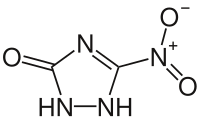
Photo from wikipedia
Development of the new, insensitive, energetic compound, NTO (3-nitro-1,2,4-triazol-5-one), creates need for the data on NTO's fate and transport to predict its behavior in the environment and potential for groundwater… Click to show full abstract
Development of the new, insensitive, energetic compound, NTO (3-nitro-1,2,4-triazol-5-one), creates need for the data on NTO's fate and transport to predict its behavior in the environment and potential for groundwater contamination. To measure the transport of NTO in soils, we conducted miscible-displacement experiments under steady state and interrupted flow conditions using eight soils having varying physical and geochemical properties. The breakthrough curve (BTC) data were analyzed using temporal moment analysis and simulated using HYDRUS-1D to determine transport parameters and better understand the mechanisms of sorption and transformation. Parameters determined from the miscible-displacement study were compared to results obtained from batch experiments conducted for the same soils, and examined in relation to soil properties. Column NTO linear adsorption coefficients (Kd) were low and correlated well (P = 0.000049) with measurements from the batch studies. NTO transformation rate constants increased and NTO recovery decreased with increase in soil organic carbon (OC) content. Autoclaved soils had slower transformation rates and greater NTO recoveries indicating that microorganisms play a role in NTO transformation. In addition, the transformation rate increased with time in soils with higher OC. Monod-type kinetics was implemented in HYDRUS-1D to simulate the observed increase in transformation rate with time. We think this phenomenon is due to bacterial growth. Results indicate very low adsorption of NTO in a range of soils, but natural attenuation through transformation that, depending on soil OC content and hydraulic residence time, could result in complete removal of NTO.
Journal Title: Chemosphere
Year Published: 2017
Link to full text (if available)
Share on Social Media: Sign Up to like & get
recommendations!